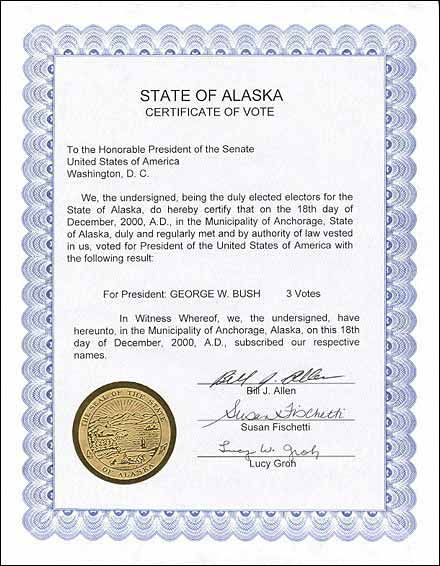The Electoral College
by Andrew Boyd
Today, we vote for president. The University of Houston's College of Engineering presents this series about the machines that make our civilization run, and the peoplewhose ingenuity created them.
The U. S. Electoral College has its seeming problems. It awarded George W. Bush the 2000 presidency even though Al Gore tallied a half million more popular votes. Yet, for its shortcomings, the Electoral College provides some very practical safeguards that popular voting doesn't.
One of the big problems with popular voting starts with its definition. Do we mean majority voting, where a candidate must win at least half of the popular vote to be declared winner? Or do we mean plurality voting, where the person with the most votes wins, even if the number of votes is less than half? Our two party system blurs this distinction, since with only two candidates whoever gets the most votes also gets at least half. But what if there were, say, five viable candidates, none of whom received more than a quarter of the vote? Do we want to claim the leading candidate the winner, even when three-fourths of the population didn't vote for him?
The Electoral College provides an answer. It doesn't guarantee someone will wind up with a majority of the electoral votes. But if no candidate gets a majority, the safeguards of the electoral system kick into action, ensuring that someone is elected.

When no candidate wins an outright majority of electoral votes, the decision falls to the House of Representatives. But there are restrictions. First, the representatives from each state don't get individual votes. They must agree among themselves which candidate they prefer and cast one vote for their entire state. Second, votes can only be cast for one of the three leading candidates from the electoral vote. If one of these three candidates obtains a majority in the House vote, that candidate is declared winner. If not, balloting continues following a round of spirited debate and deal making. In the 1800 presidential election, Thomas Jefferson needed thirty-six separate ballots by the House before winning a majority.
Without a two party system, intervention by the House would almost certainly be more common. And even with a predominantly two party system, House intervention's a real possibility. Had Ralph Nader taken just two electoral votes from George W. Bush in 2000, Bush wouldn't have won an electoral majority and we'd have witnessed firsthand what happens in the House.

Our nation's founders recognized the complexity of finding a new leader; a leader the nation accepts for four years even if he isn't uniformly embraced. The electoral system has always managed to find just such a leader. It's not perfect. And there are certainly alternatives, each with its own set of strengths and weaknesses. But we can be sure of one thing. The Electoral College was the result of careful thought by a group of most enlightened minds.
I'm Andy Boyd at the University of Houston, where we're interested in the way inventive minds work.
Notes and references:
For related episodes, see ARROW'S PARADOX and INSTANT RUNOFF VOTING.
U.S. Electoral College: Frequently Asked Questions. From the U.S. National Archives and Records Web site: http://www.archives.gov/federal-register/electoral-college/faq.html. Accessed January 25, 2011.
How Does the Electoral College Work? From the How Stuff Works Web site: http://people.howstuffworks.com/question472.htm. Accessed January 25, 2011.
The picture of representatives in the House chamber is from the Web site of the Office of the Clerk of the U. S. House of Representatives. The picture of the voting certificate signed by Alaska's three electors is from the U. S. National Archives and Records Web site.